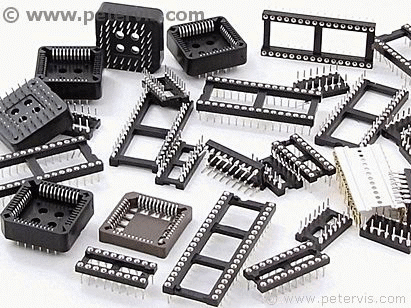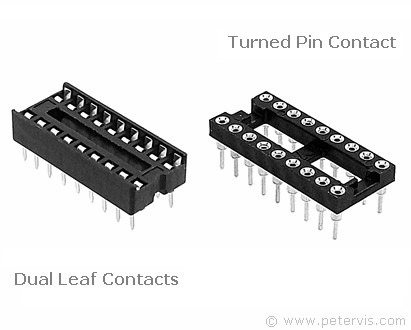DIP IC Sockets

An IC socket, also known as a chip socket, or a DIP IC socket is an electrical connector used in the field of electronic engineer. The pins of the integrated circuit (IC) connect into the socket making a robust electrical connection without the requirement of soldering. It enables an IC to connect in a circuit without being dedicating through permanent soldering.

The female contacts, also called pin receptacles, form the electrical connections and consist of two main types known as "turned pin" and "dual leaf", and there are advantages to each system.
The turned pin contact usually has tapered entry with a multi-finger spring clip inside it to make a reliable electrical connection. Usually, the more fingers the pin has, the more expensive it is. In contrast, the dual-leaf high compression spring clip is much simpler consisting of a pair of metal spring clips. Generally, contacts consist of phosphor bronze, or beryllium copper, material, and the contact plating can be tin, lead, or gold.
Another very cost-effective method is to use only the pins, known as "DIP terminals", which are available separately without the plastic frame. Usually a carrier temporarily holds the pins for alignment and soldering onto the circuit board. Once the pins are secure, the carrier removes easily leaving the pins on the board. An advantage of this system is that you can still see the PCB traces which otherwise would be covered over by the socket frame. In addition, airflow and thus thermal management is improved.
Applications
You may be wondering what IC sockets are used for, and whether you should use them, therefore this section will probably help.
Usually developers working on new electronic products may have to go through the debugging phase of the stage many times, which involves making changes to the firmware. In such a scenario, it is useful to mount the IC carrying the firmware on a ZIF style socket for easy removal.
Many integrated circuits such as microprocessors are extremely sensitive to heat, and therefore it may not be wise to solder them on a printed circuit board. In such a situation, soldering a chip socket is wiser. With the cost of integrated circuits rising, it is a good idea to recycle the chips for different projects. Hobbyists usually build on prototyping boards, however once the circuit has been tested, the same components may be used again on the final PCB.
Types of Sockets
The main type of socket used by students and hobbyists tends to be the through-hole for dual in-line package (DIP), however you can get sockets for almost any package type including surface-mount devices (SMD).
Zero-Insertion-Force (ZIF) sockets usually have a lever, which engages the contacts to make the electrical connections. Although these are mainly used for microprocessor sockets, it is possible to get these for DIP, PGA, PLCC, and SOIC packages. Typically, devices may be inserted and removed withstanding up to 10 000 cycles.
Ball grid array (BGA) packages also have sockets, which is extremely useful for engineers using these integrated circuits. BGA chips are those without pins, they simply have pads that mate with the pads on the PCB.
The plastic leaded chip carrier (PLCC) socket comes in two types, the clamshell, and the standard open top. These are available for through-hole and SMT mounting.
Pin grid array (PGA) sockets are one of the most widely used, and you can get a socket for almost any PGA IC. If you are into building computers then you will know that almost all the processors currently available have the PGA package, and the socket is usually a ZIF type.
The quad flat package (QFP) sockets are available in clamshell and surface mount type as well.
The small outline integrated circuit (SOIC) specification is one of the most popular, as these packages fit almost anywhere. You can get clamshell and open top adapter sockets for these as well. Amazingly, today, you can even get sockets for display modules as well. For example, right-angled sockets usually mount LCD displays such as a 7-segment display module with the standard pin spacing.
You can get sockets for almost any package type, and here is a small list of package types that are available.
- SOIC
- SMD / SMT
- LQFP
- QFN
- QFP / TQFP / BQFP
Adapter Sockets
Adapter sockets, also known as "backwards" sockets are usually used for through-hole DIP applications. These appear just like DIP sockets; however, they have male pins on both sides.
You can also have adapter strips, or SIL headers, with male header pins at both ends. These are useful for sandwich PCB construction.
Dimensions
The basic through-hole DIP sockets usually have a pin spacing (pitch) of 2.54 mm. Although the number of pins determines the length of the socket, the width of the socket, can vary.
Majority of the IC sockets comply with EIA / JEDEC design specifications.
Reliability
Usually sockets have to pass the military standard MIL-STD-1344 for shock, vibration, and durability. Manufacturers usually conduct a burn-in test utilising special equipment that can insert and remove a test chip many times. For a basic DIP socket with turned pins around 500 cycles tends to be the limit however, it can vary significantly for different designs and types. The IEC tests are usually as follows.
- Dry heat up to 125 °C, IEC 60512-11-9.11i
- Sub zero temperatures, IEC 60512-11-10.11j
- Vibrations, IEC 60512-6-4.6d
- Shock, IEC 60512-6-3.6c
Gold Contacts
The ASTM B-488 specification sets the use of electrodeposited gold coatings for engineering applications.
If you are building large motherboards on breadboard using IC sockets, then the quality of the connections will be of paramount importance to you, simple due to the large number of electrical connections made. With cheap sockets, you could find oxidation occurring over time and your circuit plagued with poor electrical connections.
Obviously, the more gold content there is in the contacts the better the reliability of the electrical connection. In the past manufacturers had to make the complete contact out of gold, which increased its price, however today manufacturing methods have changed and they are able to place gold only in the areas that would make the physical connection. However, the amount of gold in the connections is an important parameter to consider when choosing a socket.
Price
The cost of chip sockets is slowly dropping due to mass production in China, and therefore well worth using. The cost of a small project consisting of a handful of chips can often add-up to huge amounts, and since the cost of ICs in increasing, it is always a good idea to recycle your chips. You can buy sockets at the following places.
- Digi Key
- Maplin
- Farnell
- RS
- RadioShack
- eBay
- Amazon
- Jameco
Manufacturer
Here is a short list of manufacturers of machined IC sockets.
- Aries electronics
- Yamaichi
- Wells
- Winslow
- Augat
- Enplas
- Harwin
- Jaycar
- Amp / Tyco
Why use IC Sockets?
Just like most electronics enthusiasts, I often build a computer on prototyping board just for fun to see how well it works, however once the fun is over I always remove the chips from their sockets for other projects. It is also possible to recycle the socket itself as well thereby saving even more money. De-soldering an IC socket is a little tricky as it is made of plastic and may distort if too much heat is applied, however with some practice it is possible.
Back in the 90s, I remember getting huge scrap panels with exotic ceramic logic ICs and colourful chip sockets, which I removed and find useful for use even today. In contrast, today, nearly all logic ICs will be in a plastic package, and you can have any colour chip socket as long as it is black.
The socket material has changed a lot as well. Back in the 90s, you could get Teflon IC sockets, however today; they tend to be injection-moulded polyester known as polybutylene terephthalate (PBT).
This Article Continues...
8 Pin DIP IC Socket14 Pin DIP IC Sockets
16 Pin DIP IC Sockets
18 Pin DIP IC Sockets
20 Pin DIP IC Sockets
PLCC Sockets
PLCC Socket Through-hole
PLCC Socket SMD Mount
Wide DIP Sockets
32 Pin Wide DIP IC Socket Turned Pin
40 Pin DIP IC Socket
Metal DIP Sockets
Metal Carrier DIP IC Socket